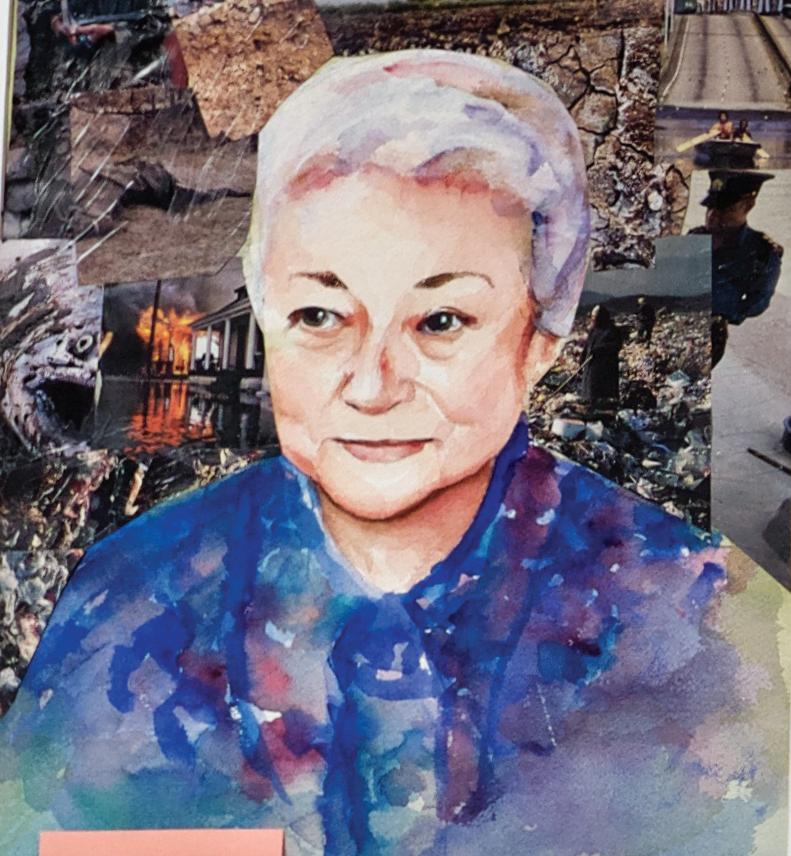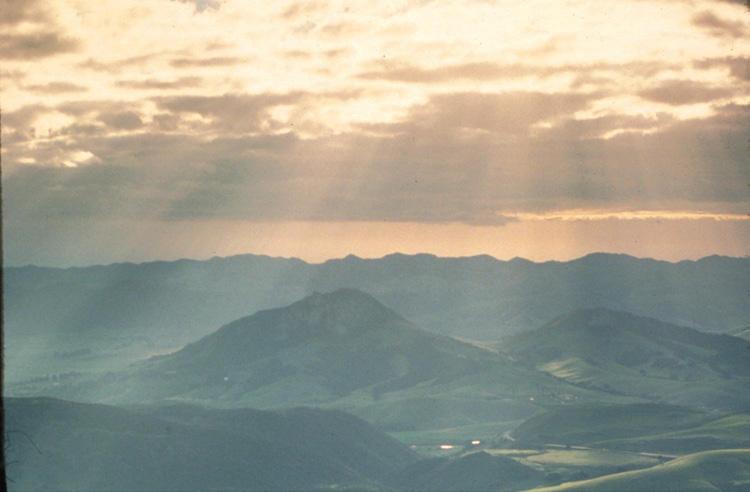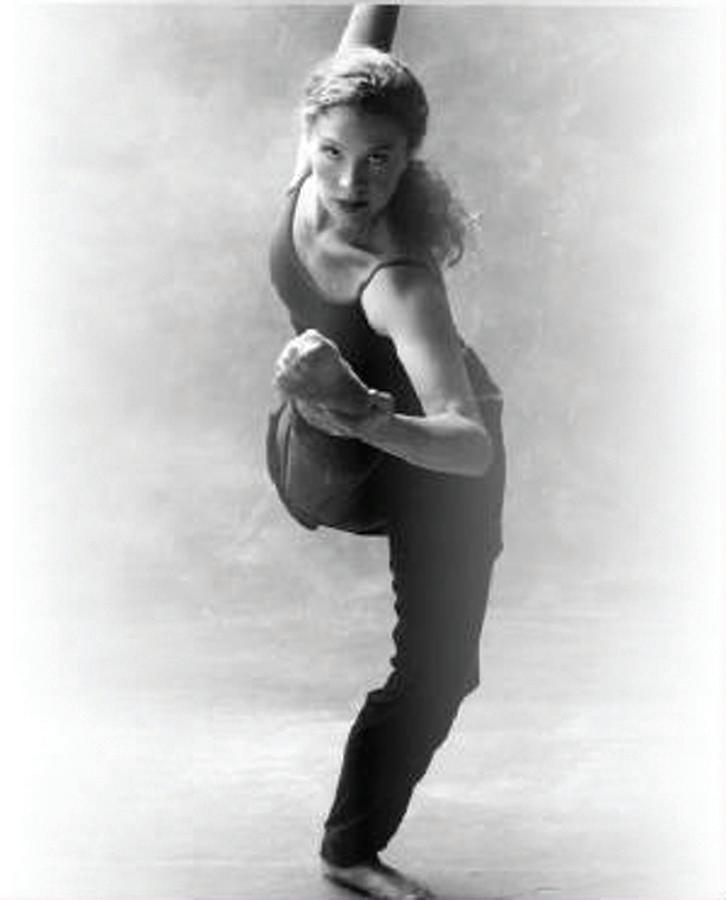






























My mom used to tell me, “Tommy, a good book can change your life.”

Although a friend had recommended it to me a few years ago, I could not bring myself to read Born to Run. What little I knew of the story just did not capture my imagination—plus I was not a runner. But, that was about to change.
When I finally did crack the book, I was intrigued by the premise of the story. The author, Christopher McDougall, a recreational runner plagued by injury, sets out to understand why his foot hurts. As an occasional jogger—two or three miles at a time, never more than a few times per month—I could feel his pain. For me, it wasn’t my foot, but my hips, which throbbed in agony after a twenty-minute trot. I reasoned that the Creator had designed my body for other purposes, stuff like sitting here at my desk writing publisher’s messages.
I don’t remember when it happened exactly, but at some point I became locked-in, engaged in a virtual conversation with the author. I was deeply entranced, almost in a meditative state as I lost myself in the story. By the time I set down the 304-page paperback, my paradigm had shifted, and I found myself practicing my stride, barefoot at the park. I was astonished to learn that McDougall was right—I really was born to run. As I strode on the soft grass, I thought about the ancient Chumash who likely glided effortlessly in the same area thousands of years ago while tracking their prey. Although I felt like a majestic Native American warrior, judging from the sideways looks I was getting from parents, in reality I was just a weird, middleaged dude with elbows and kneecaps flailing all directions, slowly orbiting their kids who were busy on the play structure.
It didn’t matter. For the first time in a long time, my hips felt great. I was so excited about my experience that, in the wake of my delusional runner’s high, I went online and signed up for the SLO Marathon. Then, I took a trip down to the shoe store where my gait was filmed and analyzed. I settled on some minimalistic sneakers that mimicked being barefoot. I asked the salesperson for some tips, and he suggested visualization. “Find a mantra,” he said. “Something you can repeat to yourself when you’re running out of steam.” I thought about this for a while, and the only thing I could come up with was Lightning McQueen from the Disney movie Cars. It probably came to mind because I have seen the film at least 800 times; half of those viewings came as my son, then two or three years old, fell asleep on my lap as we watched it together. In the opening scene, McQueen is having a dream. During the dream, he revs his throaty V8 engine violently and then declares, “I am speed.” Perfect. Shoes, check. Mantra, check.
Now, more than halfway through my training schedule, I channel Lighting McQueen when I feel myself starting to fall from my already snail-like pace on the streets of San Luis Obispo. I am speed. With the SLO Marathon penned into my calendar on April 27th, I have recruited my younger sisters, both of them runners, to pace me during the 26.2-mile race. Since my 40th birthday is also in April, they have been teasing me, claiming they are going to “escort me over the hill.” There may be something to it, as my wife has observed “exercise is the new midlife crisis.” Our generation, she says, instead of buying sports cars and searching for trophy wives, appears to be more interested in testing their physical endurance. And she might be on to something. If I were turning 40 in 1984 instead of 2014, it’s possible that rather than training for a marathon, I would be cruising around blaring Billy Idol with the top down on a newly purchased Toyota Celica GT-S convertible. Luckily, it’s not 1984, and Christopher McDougall just changed my life.
I would like to take this opportunity to say “thank you” to everyone who had a hand in creating this issue of SLO LIFE Magazine and most of all, to our advertisers and subscribers—we couldn’t do it without you.
Live the SLO Life!
Tom Franciskovich tom@slolifemagazine.com




 with Chris Bersbach
with Chris Bersbach
We shot the cover image for this issue on a roll of white seamless paper, which is our go-to choice for a portrait that has clean space for our masthead and other copy and still looks great on the cover. I use seamless paper all the time because it’s light and affordable, but I’ve also been experimenting with other options for small, portable studio-like environments. This time, in addition to white paper, I set up my 4-foot plywood background in the wooded area by the creek near Terri’s studio for some additional images that would provide a nice contrast to our cover image.
I wanted an image that would put a “studio” look into a context where you wouldn’t usually expect to see that kind of polished shot, so we hung the square background on a couple light stands and put a small flash behind Terri to pop a little light onto the background. I used a second light on Terri’s face, just like we might do in a studio, and then worked with her to ham it up for the camera.


Paden Hughes has lived in San Luis Obispo for almost ten years, starting off at Cal Poly and staying to build a career in small business ownership and consulting. It was the love of the landscape and scenery that kept her on the Central Coast, but now that she has been welcomed into the greater San Luis Obispo community, the sense of belonging makes this place her home. She strives to carve out time to be spontaneous and enjoy this beautiful area for all its adventures—and it’s a joy for her to share these experiences through SLO LIFE Magazine.

Dawn Janke has been teaching writing to college students for more than ten years. A Chicago native, she’s been living the SLO Life since 2008. Janke directs the Writing & Rhetoric Center at Cal Poly State University and moonlights as a writer and editor for SLO LIFE Magazine.

He built his career working in restaurants, as a private caterer and on a food truck that was converted from an old school bus. He and his family moved to San Luis Obispo last year to start a business of their own, The Pairing Knife, a catering company and mobile food kitchen. He is passionate about food and loves sharing his knowledge with everyone he meets, including right here in the pages of SLO LIFE Magazine.

Chris Bersbach has been a contributing photographer to SLO LIFE Magazine since 2012, focusing on photographing subjects for the regular Meet Your Neighbor story and for the cover of each issue. He specializes in editorial portrait photography, and his taste runs toward the anachronistic (especially when it comes to choosing cameras and neckwear). When he isn’t making photographs, Chris works as an environmental consultant and helps manage the local community bouldering gym and yoga studio. (He does not have a lot of free time.)

Jeanette Trompeter was born in San Luis Obispo, but lived in Northern California before returning to the SLO Life to attend Cal Poly. She began at KSBY in San Luis Obispo while in college then took off to chase her career for a few years. In 2010 she decided there really is no place like home and returned to KSBY to anchor the evening news. She does a weekly segment called “Out and About” and enjoys exploring the Central Coast as much today as she did as a student. She loves horses, our local wine country, and spending time around the water. You can follow her adventures on KSBY, jeanettetrompeter.com, through her social media sites, and here in SLO LIFE Magazine







Have some comments or feedback about something you’ve read here? Or, do you have something on your mind that you think everyone should know about? Let us know! To have your letter to the editor considered for publication in the “In Box” section, please email it to info@slolifemagazine.com. Be sure to include your full name and city. And, it’s best to keep it to 250 words or less.
Our advertisers get great results and we would like to tell you about it, but first we want to know about you and the objectives of your business. Call us at (805) 543-8600 to talk with our publisher, Tom, about different advertising programs—we have something for every sized budget. Or, you can log on to slolifemagazine.com/advertise and we can send you a complete media kit and loads of testimonials from happy advertisers.

4251 S. HIGUERA STREET, SUITE 800 SAN LUIS OBISPO, CA 93401
SLOLIFEMAGAZINE.COM info@slolifemagazine.com (805) 543-8600 • (805) 456-1677 fax
Submit your story ideas, events, recipes and announcements by visiting us online at slolifemagazine.com



Contributions chosen for publication may be edited for clarity and space limitations.
If you would like to advertise, please contact Tom Franciskovich by phone at (805) 543-8600 or by email at tom@slolifemagazine.com
So many of the stories we publish come from our readers’ great leads. We are always looking for interesting homes to profile (see “Dwelling” on page 44), have a recipe that your friends and family love? Share it with us! To get an idea, check out “Kitchen” on page 72. Is there a band we should know about? Something we should investigate? Go to slolifemagazine.com and click “Share Your Story.”

The opinions expressed within these pages do not necessarily reflect those of SLO LIFE Magazine. No part of this publication may be reproduced in whole or in part without the expressed written permission of the publisher.
Complete details regarding circulation, coverage and advertising rates, space, sizes and similar information are available to prospective advertisers. Please call or email for a media kit.
Closing date is 30 days before date of issue.
Ready to live the SLO Life all year long? It’s quick and easy! Just log on to slolifemagazine.com/subscribe. It’s just $24.95 for the year. And don’t forget to set your friends and family up with a subscription, too. It’s the gift that keeps on giving!
LETTERS TO THE EDITOR
info@slolifemagazine.com
4251 S. Higuera Street, Suite 800 San Luis Obispo, CA 93401
Letters chosen for publication may be edited for clarity and space limitations.

coziest, AND spacious! The service is excellent. The breakfast is just superb. There was absolutely no shortage of quality here. The staff is so warm and friendly. You really get the bang for your buck.









Elder Placements guides you through the difficult decision making process. After our evaluation, we take you to tour the appropriate facility that will give your parent the care and quality of life they deserve. Whether it’s Assisted Living, Alzheimer Dementia Care or Independent Living, we do the legwork for you at NO COST.








Dear SLO LIFE, Great piece on Tierra Nueva Cohousing! We need thousands of these “villages” across the country. Best cure for the ills of modernity yet.


- Sean Reilly


Many of us would appreciate more coverage about the poor placement of a new Cal Poly dorm in our neighborhood. Thanks for your attention. We beg for protection from the City as students congregate outside our bedroom windows shouting the F-word. My 5 & 7 year-old grandsons jerked awake every time that happened last week. The Happiest Place on Earth is pushing us to leave the homes that hold our family memories. SLO is turning into Isla Vista right before our eyes. If you think our neighborhoods are exaggerating the issue of hordes of students roaming our streets drunk, think again. Why would Dr. Armstrong add 1,500 freshmen to this scene into our neighborhoods, clustering under our bedroom windows? This is a thoughtful plan? An execution of Cal Poly’s Good Neighbor Policy? - Claudia Andersen
>> Thanks for contacting us, Claudia. We receive a lot of letters like yours concerning Cal Poly student housing and have decided to follow-up with another story on the matter. Please turn to page 58 and read all about it.
The Dan Berkeland interview just summarized all of the reasons I love living here!”
- Sarah
I knew Dan when we were writing code on our Commodore 64’s for a cool basketball game; never saw this coming…”
- Jason Tenney

Dear SLO LIFE, I just finished reading the article written by Tom Franciskovich. This well written article covered all the questions I have been pondering since I moved to SLO. I still have concerns about the seismic activity around the plant. No one can control Mother Nature’s force and no one knows what will really happen if an earthquake strikes. We most definitely learned that from Fukushima. I have one more thing to say... Go Mothers for Peace, keep watching.
- Ellyn Houghton
Dear SLO LIFE, Having worked at the Nuclear Regulatory Commission (NRC) for 31 years, I can tell you that the Mothers for Peace gave Tom Franciskovich incorrect information when they said the NRC is “85% funded by the industry.” Every year, Congress gives the NRC its funds from the US Treasury. The NRC bills utilities for 85% of those funds, but the utilities send those funds to the US Treasury for Congress to do with as it sees fit. So, saying “Now, you don’t bite the hand that feeds you, right?” appears to be intentionally misleading by the Mothers for Peace. They have been interfacing with the NRC for over 40 years and know that information they supplied about funding is incorrect.
- Lawrence Mark Padovan
>> Editor’s Note: the area of land that PG&E owns at Diablo Canyon is actually 12,820 acres. The 750 acres that were cited in the article referred to just the space the power plant occupies.
Dear SLO LIFE, I loved Renee Besta’s photo of Mission San Miguel. I spent many years as the Project Manager reopening and restoring this mission and Renee is right... Folks having been drawn to it over the years, and if those walls could talk, what they’d share. We actually discovered an old bullet lodged in the wall where someone, obviously, shot off a gun inside! Each mission is unique and has its own story to tell, thanks for reminding me what a jewel they are.
 - John Fowler
- John Fowler
Please send your comments to info@slolifemagazine.com

Follow SLO LIFE on Facebook: Visit facebook.com/slolifemagazine Visit us online at slolifemagazine.com
Letters may be edited for content and clarity. To be considered for publication your letter must include your name, city, state, phone number or email address (for authentication purposes).
As a real estate photographer based in Morro Bay, Cavan Hadley is often found hanging halfway out of a helicopter shooting a variety of different properties, including the occasional mega yacht anchored away in some exotic international mooring. But, last December his travel schedule slowed down just enough for him to charter a flight and have some fun in his own backyard.

The whirlybird circled Morro Rock several times as Hadley snapped away with a fast shutter speed on his Canon 6D, which was fitted with a 16-35mm wide-angle lens. He was not sure what he had captured until he sat down at his computer to view
the photos the next day. Staring back at him on his screen was the image you see here, an unusual perspective of the most iconic landmark on the Central Coast.
Much has been said and written of the “Gibraltar of the Pacific,” but to Hadley, who had been a sailor for 24 years, it is a safe haven and the only harbor between Santa Barbara and Monterey. “If you ever find yourself lost out there,” Hadley points toward the horizon, “or caught in a gale [heavy storm], Morro Rock is the first thing that will turn up on a radar and the first thing you will see through the fog on your way back home.” SLO LIFE

The three iconic 450-foot Morro Bay smokestacks constructed in the 1950’s were officially shut down. At its peak production the facility served nearly one million customers on the Central Coast and in the Central Valley while burning 500,000 gallons of oil per day. In the wake of the closure, Dynegy, the plant’s Houston-based owner, applied with the Federal Energy Regulatory Commission to create an offshore wave farm. Officials at Dynegy estimate that it would create 650 megawatts of electricity and would provide the City of Morro Bay with an estimated $1 million in annual revenue.

After a five-year struggle to reaffirm its good standing with the Accreditation Commission for Community and Junior Colleges, Cuesta College President Gil Stork announced that the college is no longer in sanctions. The next round of self-evaluation is due to the commission in June, and Stork stated that the college already has “2,000 pieces of evidence to support the 2014 evaluation.” Cuesta College also launched a website to make the evaluation process “more open and transparent to the community.”

A group of Nipomo Mesa residents banned together to sue the County and the State Park Off-Highway Motor Vehicle Recreation Division, operator of the Oceano Dunes. Citing research indicating that the off-road vehicles at the Dunes are creating unhealthy living conditions on the Mesa, the frustrated residents’ lawsuit claims that the “protection of public health” has been disregarded.
Lady Gaga shot a music video at Hearst Castle, which prompted the suspension of Nicholas Franco, the State Parks executive who oversees the castle. Two weeks later Franco was reinstated and the record was set straight: Gaga donated $250,000 to the Hearst Castle Preservation Fund; reimbursed all costs, including the castle’s $22,100 special fee; underwrote a $25,000 water supply study; and, most importantly of all, in light of the drought, no water was wasted in the process. Gaga and her crew dropped in at the Cambria Ale House when shooting ended to celebrate.


Amid strong opposition from its neighbors, the San Luis Coastal Unified School District chose to abandon its plans to build an 88-unit residential complex on Johnson Avenue. However, the district vowed to press on with plans to build a smaller development on the 4.4-acre hillside property as way to resupply its cash-strapped general fund.

The Cal Poly men’s basketball team completed a magical run to cap their season and earn the school’s first ever birth at the NCAA Tournament. In an improbable three-night stretch the team played as underdogs yet continued to win. With time running out, Mustang freshman point guard, Ridge Shipley, stopped at the top of the key for a jumper that rattled around the rim before falling to secure a dramatic one-point victory over Cal State Northridge and a trip to The Big Dance in Dayton, Ohio for a chance to compete for a national title. After winning the first round, the Mustangs were eliminated from contention by Wichita State in St. Louis.

The City of San Luis Obispo was told by a state administrative law judge to restore binding arbitration as a means to negotiate wages and benefits for its police and fire unions. The overturn of Measure B, which 73% of voters supported in August, 2011, came as result of a claim filed by the San Luis Obispo Police Officers Association in October of that same year. Following the announcement, the city council voted unanimously to appeal the judge’s ruling setting up an unprecedented legal battle.
The Board of Supervisors officially declared the County to be in a state of drought emergency. The US Drought Monitor classified SLO County with its most severe designation, describing it as experiencing an “exceptional” drought. Against this backdrop, the County gave a green light for exemptions to its planting moratorium allowing 21 vineyards to plant an additional 1,500 acres in the North County, which will use water from the Paso Robles groundwater basin as its irrigation source.

By a 5-0 vote, the Oceano Community Services District (OCSD) board of directors terminated its general manager, Lonnie Curtis, who was just five months into his tenure at the trouble-plagued agency. It is the third consecutive GM to have been fired at OCSD, but at least the board was able to cut the cord before being required to kick in $63,000 in severance pay. Curtis, who was recruited from the Los Angeles area for the $126,000 per year job, reportedly “flipped off” a bystander as he drove out of the parking lot in his SUV for the last time.



After eight years as Deputy District Attorney, Dan Dow is seeking a promotion. In what is shaping up to be a close race in the June election for the office, Dow and his colleague Tim Covello will square off to replace District Attorney Gerald Shea, a 16-year veteran of the 95-person SLO County department.
So, Dan, how did you get your start? I joined the Army and they said, “We need linguists right now and we think based on your scores you’d be good at learning languages. We want you to be an Intelligence Cryptological Linguist and we’re going to teach you a foreign language.” So, after getting my security clearance stuff done, they sent me to the Defense Language Institute in Monterey. They said, “We’re going to assign you a Category 4 language,” which happened to be Korean. I was there for a year. It was studying eight hours a day. The language is fascinating, but I never, as a youngster, would have said, “Hey, I want to go learn Korean.” I just wasn’t exposed to it. But because of the Army, it opened up a whole new set of life experiences and it was very rewarding.


What do you remember about your time in Korea?
I grew up in Maine—Korea was like Maine, probably even colder though—quite a bit colder, but an absolutely beautiful country. The elderly people, particularly way out in the villages where they still remember the Korean War, would treat you so well being an American soldier. I remember one time when we broke down in the middle of an extremely cold winter night. The trailer that we were pulling behind our truck had the wheels lock up; they were literally frozen shut. So, we found a discarded tin can on the side of the road and filled it with diesel fuel. Our idea was to light it on fire and place it underneath the axle, thinking it might warm it up enough to unfreeze so we could then start to roll again. It took forever, but we finally got it lit. My partner then stood up quickly and slipped on some ice and the flaming diesel fuel went flying out of his hand and landed in the rice paddy next to the road. So we’re jumping around in the field trying to stamp it out when this elderly woman—it must have been about 3 o’clock in the morning at this point—comes out of this little house wearing only a nightgown; it was probably 15 or 20 degrees below zero. She brought us a hot pot of coffee and proceeded to thank us for our service. Here we were practically setting her crop on fire and she’s making us coffee and thanking us.
When were you first exposed to the criminal justice system? I was 32 and in my second year of law school when I received a 24-hour notice that I was being deployed again. They told me initially that I was going to Iraq; but the Army said, “No, we’re actually going to send you to Kosovo.” I was on a human intelligence team. We were responsible for finding war criminals, looking out for people that had been previously identified and had never been brought to justice. So we were looking for them, actively going out into the communities, talking
with the Serbian population, talking with the Albanian population, developing friendships and relationships, and all the while, hopefully, collecting good information so that we could find the bad guys, the people who had committed the war atrocities. We were also looking for other crime that was tangentially related to that, like the smuggling of weapons into the country. We would be gathering intelligence so that we could track and, hopefully, find these people, while also doing our best to maintain the peace between the Kosovar Albanians and the Serbian populations that lived there.
In the DA’s office you have developed a reputation for your work on sexual assault and domestic violence prosecutions. Why focus on these areas? These are very, very serious and important cases; and I find them rewarding because they’re challenging. But, I also know that you can’t make anything better for the victims, so you do everything you can to vindicate what happened and support the family, support the victims that are there, help ease the burden that they have, and make sure that their rights are protected; and make sure that the process goes forward and you achieve a just outcome. And a lot of prosecutors don’t really care for those cases because they’re complicated. And when I say complicated, it’s because they have so many different competing dynamics. If you think about it, a victim of an intimate partner crime is often so emotionally tied to the perpetrator that they have a hard time separating themselves from the abuser. You’re dealing with people at a very critical time of need in their lives.
But, your work in this area was interrupted a few years back, correct? Yes, if somebody is in the National Guard or the Reserves, and they get called up, you’re subject to a Federal Order. So, in 2010 I had orders from the President of the United States that said, “Captain Daniel Dow, you’re being ordered and called to active duty and you have to drop everything else you’re doing and go off to war.” It was a tough year for my family. My daughter, Chloe, was five years old, and my son, Jed, was three. We did a lot of Skype, and I missed them like crazy. My wife was 100% supportive, and has been for the 21 years we’ve been married. It was definitely an experience. You know, I wouldn’t necessarily say anybody wants to go off to war, but when you’ve been trained to do what you do and you know that your comrades, your brothers and sisters at arms, are overseas doing what they’re doing, you feel like that’s where you can contribute the most. So I’m glad, in that context, that I had the opportunity to serve. I’m eligible to retire from the Army in June, so no more deployments for me. My commitment is here to this office.
















As Executive Director of the Child Development Resource Center of the Central Coast, Terri Kurczewski (pronounced ker-chess-key), has led the organization to open the Sm(art) Studio in San Luis Obispo, a creative space which encourages community members to express themselves through art by using recycled materials. She is a passionate advocate of Central Coast children and their families. Here is her story…

Okay, Terri, how did you end up on the Central Coast? I’m from San Diego originally, and this is like a super boring story, but I had a really good record for getting into car accidents—actually many of them are not my fault. And finally, the last one I had, totaled the car. So I’m sitting with my parents at dinner and they said, “Well, we don’t know what’s going to happen now.” And I said, “I just need to move some place where I don’t need a car.” We narrowed it down to either San Luis or San Francisco. And I was like, “Please, San Francisco,” but I ended up here for a couple of years, taking the bus to Cuesta. I got a job working at the SLO Chamber Visitor Center and I tried to really be acquainted with the community. I learned so much about how the relationships of the business community, tourism, and just how everything kind of works together. Then I got married and moved to the Bay Area seeking fame and fortune in grad school and all those things.
So, what happened?
I thought to myself, “Oh yeah. I’m going to be an academic and get my PhD and be super fancy.” One of my professors said, “I think you’d really like teaching. I think helping people is actually your want in this world, and your desire.” And she said, “Let me put you in touch with one of my friends who is a teacher in the East Bay.” And so I did that and I started applying. I applied at a charter school right out of college where you don’t need a credential right away, or at least you didn’t at that time. I really
wasn’t one of those people who grew up saying, “I love children,” but I felt that if all children could read then we would equal the playing field. That would be some kind of equity and justice work that I could do for the greater community.
I’m from a very religious family who said, “We’re all equal and God loves everybody and everything’s fine and just be nice to people and they’ll be nice to you.” I mean, I say “Hi” to everybody, but people in the inner city were calling me names. And it was very eye-opening to me that people hated me for who I was. I really had no idea about injustice. So, I thought, instead of just handing out turkey sandwiches at Christmas, I could actually work to change the system. But, now I’m old and tired. [laughter] I think changing one family, inspiring a child, and mentoring the next generation of Poly kids that are going to change the system, that’s more my role now. I used to look up to the people that were like superintendents of schools back then, you know, those really high achieving types. Now I think the system’s way more broken; that’s why people are still experiencing such multi-generational poverty and racism. They are just stuck in these institutions that don’t work and I’m like, “Wow, I would love to stop this.” But, I know I can’t do that on my own. So why don’t I work in my small way and do what I can to help? You know, pay it forward to maybe the next group of people who may be able to do something about it.
Is religion still a big part of your life?
My stepdad was a Catholic deacon, but no. My daughter’s really Catholic now. I pick her up from school and she’ll say, “Let’s go see the beautiful church.” I’ll say, “Right on. Let’s go do it.” And I get that. I was very, very Catholic when I was a little girl, you know, because that’s what I saw. So I get her impulse to feed her spirit in that way, so I say, “Okay, yeah. Let’s support it.” We watched Jesus and the Leper on YouTube together the other day. But, again, that’s my philosophy as a parent and her dad’s, too. We’re going to give her a broad spectrum of choices. We’re going to let her know what’s safe within those choices and if she >>

...the system’s way more broken; that’s why people are still experiencing such multi-generational poverty and racism. They are just stuck in these institutions that don’t work and I’m like,
“Wow,
would love
stop this.” But, I know I can’t do that on my own. So why don’t I work in my small way and do what I can to help?
wants to be Catholic then we totally support her and we will do everything to do that, as long as it’s meeting her needs. I’m actually Buddhist, but my daughter goes to Mission so don’t tell anybody.


Why not? Aren’t Catholics cool with Buddhists?

[laughter] Oh totally! Buddhism is more of a meditation. When you’re dedicated to your meditation practice it completely transforms your life, absolutely. And there is something called the Sangha, which is a religious community. So you come together and group-meditate, and there are several of those in San Luis. Then they barbecue and stuff afterward. It’s not like being Catholic because Catholics love to party, which is awesome. But Buddhists, we don’t party that much—just some tea drinking. It’s also more of a philosophy as much as it is a religion. So I feel totally comfortable being both and going to church and understanding those things.
How did you become a Buddhist in the first place?

I loved this boy who was a hippie-vegetarian-Buddhist-surferguy. And I thought, “Oh, that’s kind of weird.” And so then I started studying it more and went, “Wow, this is what I’ve been looking for my whole life.” This idea of just being calm and still, and being grateful, and being thoughtful as a centering philosophy. I think it’s so essential to who I am. I studied religion in school. And I said, “Oh yeah, I want to be a big, great religion academic,” and my family said, “No.” But then I realized what I liked about it was the sociological aspects of it, like the concept of being a good Christian, for example. So I continued to study Buddhism and thought, “Oh this is my way.” My mom is a go-to-church-every-morning-kind-of-lady. That’s her way. She finds such a, like, euphoria from being in that space that I


“Wow, this is what I’ve been looking for my whole life.” This idea of just being calm and still, and being grateful, and being thoughtful as a centering philosophy.
I think it’s so essential to who I am.
They Seem” by Teri Peterson
“Leisurely Sail Through
Ness” by Rebecca Martin
“Inheritance” by Terri Kurczewski
“Fashion Landscape” by Terri Kurczewski
don’t have, but I totally respect that we all like different kinds of ice cream and that’s the kind I like, you know? It works for me.
Okay, let’s talk about the Sm(art) Studio.
So I realized I can make a small but significant impact in this world where I’m helping support people and creating within themselves the idea of being self-sustainable and making stuff, beautiful things. And these are things you can’t buy. And nothing on a screen can really enhance your life and make you feel successful or happy. And I know personal relationships do that too, but I just think art has a way bigger reach. It can have such a big influence to the positivity of people’s lives and their relationships and it’s something I think as a Americans we’re not brought up to appreciate. Not the way that they are in other countries, for sure. And so that’s why I love this studio project, because it’s like, “Oh everybody’s leaving happier than they were coming in.” And by opening the studio up to the community in a larger way, it allows me to also make an impact in something that was not what I originally set out to do. I’ve never been an artist, and had never picked up a glue gun until I opened the studio.
Let’s get this straight. You’re not an artist, but you started an art studio?

We’ve all become so process-driven in our lives. Doing this leads to that. Art is not that way. It’s an expression. Anyone can do it. So much of the time we are so logical and focused on what we’re supposed to do. And art, wow, it’s… it’s the opposite of all those things. I won’t lie that some nights—like we have one night each month called “ladies night” where a little wine really helps relieve some of the anxiety they may feel to “do it right,” but that’s not what it’s about. The ladies who come in and engage in those activities often at first feel pressure to make it beautiful, but absolutely it’s about the expression. It’s especially powerful when kids and parents work together, and that dynamic is something that has to be overcome. It’s like, “Bobby, but you have to do it this way,” and I’m like, “You know, they’ll never grow as an artist unless they make mistakes.” And it’s kind of cool because all those parenting things they teach you and all the things you learn in school about human development, they’re so applicable in art. You can’t learn unless you make mistakes—you can’t do it until you try over and over again.
I was in roller derby. I did that for a while until I realized, “Oh actually, this is scary.” [laughter] I write a horrible blog. My daughter, Vera, and I paint at home, and I’m pretty bad at that. We play card games. I like going to Art After Dark. My favorite thing is to travel. So every year I save money to go somewhere. I like hitting the pavement at six a.m. and



What sort of things have you tried and failed at?
We’ve all become so process-driven in our lives. Doing this leads to that. Art is not that way. It’s an expression. Anyone can do it.
coming home at two in the morning, just taking in every minute. Yeah. Like ten museums and a jazz show. I’m a people watcher, and the world’s an interesting place and I love being in the middle of a city in some other country; and being invisible; and just having a cup of tea and watching people walk by; and just wondering what their lives are like. People are so fascinating and what I’ve learned after all these years of travel and all these years of working with people who don’t come from my background or have not experienced my privilege, we actually are more alike than different. And remembering and being grateful for all those ways that we are so similar, even though we might live across the world from each other.
After spending the day helping kids find success, how do you help your daughter find her way through life?
We try to make time to just paint together or play cards. Working amongst the therapists in our organization has helped me speak a different language in a way. I’m always checking in on how she is doing and trying to be my best parent. And what I have noticed is that the conversations happen so much more naturally over a game of cards like, “Oh yeah, so I’m having these thoughts about school.” Or, “I was worried when you said you needed to talk to me.” Those kind of things, so I’m having those simple times where we’re doing activities; but also being able to spend some good times and having those important mom and daughter conversations.
And what about your daughter, can you tell us about her? She’s seven and in the first grade. And so, luckily for me, she has basically grown up in a school. So if I need to be at work and I bring her along, she is completely comfortable. It’s like a second home to her. You know, she’s really a part of what I do and that’s important for me as a mom. It’s showing her that you’ve got to do everything you can to be happy and to be a good part of this community. To be caring and respectful of all people because we’re all interrelated. But also that it takes a lot of work, because it’s really easy to be happy when the only thing you’re worrying about is how many afterschool activities you’re going to do. What I want to do is show her, “No, I’m happy because I work really hard to make sure that my needs are met and that I’m helping other people which makes me happy.” She’s seen that her entire life because I was a school principal when she was just a year old. So, for her, it’s been that way the whole time.
I’m constantly saying dorky things, like “Joan of Art” or that I’m having an “Art Attack” or something equally silly. I love a good pun, but I love a bad pun even better. I’m really clumsy and am always bumping into things and people. Oh, and I’m notorious for misspelling emails to my disadvantage. Just the other day I sent off an email to one of our funders that said, “I hope your week has not been too busty,” instead of “busy.” [laughter] But, honestly, there have been times when I’m like, “Oh, maybe I should just go back to being a minion and let other people be the boss.” I just think the most important thing is that I completely believe in the work that we’re doing. So no matter what, it’s not about me. I happen to be good at what I do. That’s my talent in the whole scheme of things, but, actually, I have a really amazing staff that does really amazing work and so however I can support them on the backend, that’s what I feel like my role is. And I just want the people in this community to have positive experiences with their families and at school; that’s what I’m all about.
...that’s important for me as a mom. It’s showing her that you’ve got to do everything you can to be happy and to be a good part of this community. To be caring and respectful of all people because we’re all interrelated. But also that it takes a lot of work, because it’s really easy to be happy when the only thing you’re worrying about is how many afterschool activities you’re going to do.






I like a modern style. Clean lines. Simple. Less is more. More minimalist. It fits my aesthetic. I don’t believe in staining wood. I like to just use what is there naturally. I don’t like exposed, fancy joinery. I prefer to keep everything hidden. I’m not into the woodworkery-sortof-thing where it’s all about showing off the joinery. It’s more about the design for me than that kind of stuff.



I also sell smaller items on Etsy, things that are kind of fun. My mailboxes have been really popular and have been paying the bills lately. I also have some ceramics on the site, and an art piece. I’ve made four or five cribs now. They each take about 120 hours to make. I built an armoire, which took over 140 hours. Tables are usually about 50 hours—a week or so—they’re much easier to build.
Creating something tangible is definitely the way I think, and the way I see things; I mean, I cannot draw. If you say you’re an artist people automatically think you can draw, but it’s the actual threedimensional things that I can put together. That’s my thing. It’s nice to stand back and see what something looks like after it’s done. Sometimes it’s more than what you expected, and sometimes it’s not.
I don’t do anything crazy with power tools. Some people do crazy stuff. I feel comfortable using the machines. The table saw is probably the most dangerous. I have a huge bandsaw. I’m grateful for having that, it’s really nice. Keeping the dust down is the hard part.







As a boy growing up in Seattle, Michael Wolfe wanted a sailboat. He loved to sit on the shore of the Puget Sound and watch the beautiful vessels gracefully and quietly skim across the top of the emerald water. But those boats were expensive, and way out of the budget. So, he found a more affordable option: windsurfing.

When he was twelve years old, his parents told him that a job was forcing the family to pack up and move to a little town in California called San Luis Obispo. It was not long after his family had settled before Wolfe began searching around, asking about windsurfing in the area. He was told to go find someone named Richard Crowe at Lopez Lake. The first two or three sessions were rough for Wolfe, as he struggled mightily against an unpredictable wind. After seeing the enthusiasm of the young windsurfer, Crowe approached him and offered some advice, and gave him his phone number, which the tight-knit windsurfing community at Lopez Lake considers a rite of passage.
Today, during his workday, Wolfe owns and operates a computer and networking consultancy he calls Good Electrons. He likes to joke that he is “non-denominational” since he works on both Macs and PC’s. But, from May through September, when the conditions are right, and the wind is blowing just so, he can be found out at Lopez Lake along with around twenty other hardcore windsurfing enthusiasts from the Central Coast. “There is even an architect out there who works out of his RV next to the lake waiting for the wind, which is so fickle,” shares Wolfe. “It can be blowing just right at 10am or at 3pm. You just have to be ready for it.”






Ever feel like you’re being buried? By work, by obligations, by your own thoughts? You know what can help?
Rising above it all. And I mean that in a literal sense. Because getting up, up, and away from it all can make quite a difference.
BY JEANETTE TROMPETER, KSBY NEWSThere’s a certain magic that happens by simply getting out in nature at sunrise. Add a big beautiful balloon to the mix, the soft light of early morning, and well... it takes you to a whole new level.
John Warren loves sharing the beauty of the Paso Robles landscape from a vantage point few ever experience. A pilot for more than 40 years, he took his first balloon ride a decade or so ago and was hooked. Now he owns Let’s Go Ballooning and shares the experience with people like John Riley and Tera Yeo, who came down from Folsom to get up, up, and away for Riley’s birthday. “He’s hard to buy gifts for, so I figured an experience is better than a gift,” said Yeo. Fortunately, I got to tag along on their birthday adventure. “Alright, I’m going to warm this up slowly and we’re going to go for a ride,” says Warren as he starts heating the air already fanned into the balloon.

As a bit of a recovering adrenaline junkie, I’ve
done my share of airborne adventures, but this is unlike any of them. It is as peaceful as it gets because we are floating more than flying as we rise above the ground below. “All we control is altitude,” says Warren as we float over trees, down near vineyards, and up high over it all for a nice panoramic view of the Paso Robles landscape. “The lateral movement all depends on what direction the breezes are coming from,” he adds.
Direction is determined largely by Mother Nature. We simply catch a ride on the wind currents by rising or drifting and descending into those that are heading the direction we want to go. It’s like catching a wave of wind.
“The control we have is infinite,” explains Warren. “If the movement’s not there, you can literally just sit in the top of a tree. You know we’ve picked walnuts out of the top of a tree before, and that’s pretty wild if you think about it.”
There’s an amazing calm to the experience. The only sounds come from the occasional flames
that keep us airborne and those from the waking world below. “The fact there’s no breeze, no sense of motion, and you can get so close to everything, and you can hear everything,” Warren reflects on the magic of ballooning.
“You know the idea—you can hear the birds chirping or the frogs croaking...” If the wind is right, you can even get close enough to see where the sounds are coming from. We never saw them, but we kept hearing the coyotes that clearly saw and heard us every time Warren fired up the flames to keep us airborne.
Warren flies primarily around the Templeton Gap and is up almost daily when the weather is right. But every day is different, he says, depending on the way the winds are moving, where the sun is rising, and how the scenery’s changing. One thing remains certain: it is always spectacular when you can rise above and simply go with the flow.
Jeanette Trompeter, KSBY News anchor and reporter, hosts the “Out and About with JT” series every Tuesday evening at 6pm.

After American Dirt released their debut album, Heavy Thought and Riddle , on Twang N Bang Records in July 2013, UK-based Mudkiss Online Fanzine posted that “the bands’ name is really appropriate, as you get the feeling they produce a sound which is very much from the American heartland rather than the shiny, artificial, Hollywood US of A image that [us Europeans] so often get force fed.” Funny—American Dirt may not be part of the glitz and glamour of Hollywood, but they are born and raised California boys who reside just three hours north of LA, right here in San Luis Obispo County.
Lead vocalist Dave Wilson grew up in Atascadero and formed the band several years ago; bassist Brian Sonniksen, a King City native who has lived in SLO County since 1998, paired up with him a year later. The band has seen a few other members since its inception, but the most recent iteration includes another A-town resident, lead guitarist Jon Bartel, who joined in 2011. Bartel says about the band’s name, “Yeah, I remember someone commenting that American Dirt is probably the perfect name for whatever it is we are doing.”
Mark Folkrod, who was born in LA but is a long-time San Luis Obispo resident and who also plays with local band the Dead Volts, began as the “summer drummer” of 2013 after Dirt had already released Heavy Thought, but as Wilson says, “The second we started playing with Mark we knew we wanted him in the band.” Bartel adds, “Our music has changed since Mark joined the band; he is a part of the song-writing process—not just the guy behind the kit.”
Dirt’s sound has what ninebullets.net music blogger RomeoSidVicious calls “rough edges in the all the right places with some pretty amazing melodies hanging out where you’d least expect them.” So, American Dirt is solid and soon begins recording its second album. Wilson says, “We learned a lot from our first record, and I’m really excited for this next one.” He continues, “I think our attitude is ‘Wow, if you liked that, then wait until you hear
this.’” Folkrod adds, “We invested in recording equipment with the Dead Volts and we’ve got plenty of material.” Bartel quips, “We’re gonna take our time.”
Taking their time includes what Sonniksen jokingly refers to as an upcoming “Old Men with Responsibilities Tour” up and down the state. He says, “We’re continuing to do what we have been doing. We’ve made great friends in Sacramento and Santa Barbara, and we just like playing with the musicians we’ve met.” But all these guys have day jobs and families, so their tour will consist of extended weekends. Folkrod jumps in to question, “But what else are we gonna do?” Wilson explains, “Some guys wear football jerseys. We wear band t-shirts. We just get to go on the field for a little while now and then.”
As they continue to play the alt country field, the band is pretty happy with the connections they are making across the states. Upon the album’s release, Twang N Bang Records label head Patrick Hayes sent Heavy Thought and Riddle to well-known music blogs and podcasts, and word about American Dirt has spread. Stagger Lee out of Georgia played the band on his “Working Class Radio” show, which is broadcast by Silent Storm Radio; rockymountainradio.net added a few songs from Heavy Thought to its 24-7 Hootenanny playlist; and the W.B. Walker’s Old Soul Radio Show podcast recently featured Dirt’s music alongside alt country favorite, Son Volt. Wilson is humbled by the accolades: “Wow, people I’ve never met like what we do. It’s not just friends who feel obligated.”
Indeed, their fan-base is not made up only of friends who feel obligated to support them. But perhaps what’s even cooler is the way in which American Dirt gives back and supports the SLO County community; they’ve played a number of benefits and other fundraisers. Bartel says, “We get invited mostly because we’ve been in the area and know people.” “We’ve all been in different bands at different times,” adds
Folkrod, “so someone will call and ask us to play a gig.” The community is “such a cool thing to be a part of,” says Wilson.
Bartel continues by observing that community is pretty much how they approach everything: “We perform mostly at our friends’ places—and it’s not like we play there to help them out. We prefer it.” American Dirt jams regularly at Molly Pitcher Brewing Company and Camozzi’s in Atascadero, The Libertine Pub in Morro Bay, and SLO’s Frog ‘n Peach Pub. “It’s definitely communal,” says Wilson. Bartel adds, “It’s a testament to the Central Coast that there’s a lot of pockets of places to play music. It’s cool to live in a place where you have such a range.”
“Everywhere in this county there is a different vibe,” says Wilson, “and it’s so gorgeous.” He continues, “We get to be so in touch with things; we’re surrounded by nature… How lucky are we? North, south, east, and west— the Central Coast is amazing.” I think that Mudkiss music reviewer nailed it with these guys: as the band discusses life on the Central Coast, it’s clear they’re organically rooted in Americana rather than a genetically modified version of musicianship some believe comes out of Hollywood.
One thing the band members celebrate about the local music scene is that there is so much happening in different ways, in different genres. Wilson explains, “To have as much variation as we have in this small of a space is incredible,” and Bartel adds, “There is just so much good music coming out of this county.” Sonniksen sums it up: “We get to do the thing we like to do and live in a place where we like to be.”
When asked what song on Heavy Thought and Riddle defines their sound, the members of American Dirt unanimously reply that with its mid-tempo country moments and its rock-n-roll outro “Leave My Mark” is most representative of their range as a band. A little punk bang and a little country twang—sounds like SLO Life to me, and these boys are livin’ it.







A sixteen-year-old Arroyo Grande High School junior and the youngest of two children, Sophie Whittle is an athlete at heart.
What do you like to do for fun? Other than my interest in tennis, I enjoy playing beach volleyball, listening to music, and spending time with my friends and family.
What is noteworthy about you? I am a three-year league MVP and I was featured on KSBY News in a segment called “Legend in the Making.” In 2012 our AGHS girls’ team fell in the finals of the CIF Southern Section, but in 2013 we won the CIF Southern Section title for the first time in girls tennis history at our school.
How do you spend your time outside of school? I am involved in teaching younger junior tennis clinics, and working out at the gym or with my athletic trainer.

What is your favorite memory of all time? Winning CIF as a team this past year was incredible—playing with such an amazing group of hard-working, motivated girls and being able to have the opportunities we’ve been able to have because of our Coach, Lori Hollister.
What career do you see yourself in someday? My dream is to become a professional tennis player. I would also enjoy being a physical therapist because I really like being around athletes, and I would want to help them heal from their injuries.
How would you describe yourself? I am a very competitive, caring, and social person. I love meeting new people and helping others when they need it. I am a very positive person and I live each day to the fullest and really enjoy life.
Who or what has influenced you the most? My mom has been a huge influence for me throughout my life. She has always supported me through everything I have wanted to do. She takes me to tournaments every weekend in Los Angeles and has always been there for me when I’ve needed her.
What is it that you look forward to most? I am looking forward to college because I am excited to meet new people, challenge myself academically and also with my tennis game.

If you could go back in history and meet anyone, who would it be? I would want to meet my great grandfather who lost both of his legs and one of his arms in a train accident and continued living his life to the fullest and enjoyed every day as if it were his last.
What schools are you considering for college? I am keeping an open mind about where I could see myself for the next four years in college, but ideally I would love to stay in California or on the West Coast because the weather is unbeatable.
Know a student on the rise?
Introduce us at slolifemagazine.com/share













1. In 2009 Justin Brody began to study wine with the Court of Master Sommeliers gaining his certified sommelier credentials in 2010. While maintaining multiple wine lists, Brody’s goal is to keep both restaurants’ wine programs approachable, balanced and unique. Luna Red and Novo each offer Wine Spectator awardwinning wine lists focusing on both local and international wines.

Luna Red 1023 Chorro Street, San Luis Obispo (805) 540-5243 // lunaredslo.com
Novo Restaurant and Lounge 726 Higuera Street, San Luis Obispo (805) 543-3986 // novorestaurant.com
2. Wild Horse’s 2012 Chardonnay has delicious aromas of lemon and a hint of pineapple. Flavors of green apple and vanilla unfold on the palate with a crisp refreshing finish. Small lots of Verdelho and Malvasia contribute bright acidity and heightened aromatics to the blend.

$16 // Wild Horse Winery & Vineyards 1437 Wild Horse Winery Court, Templeton (805) 788-6300 // wildhorsewinery.com
3. If you’re ready for fresh local fare it’s time to sign up with SLO Veg for your weekly or biweekly deliveries of fruits and vegetables from local farms accompanied by seasonal recipes.
$27.82 - $40.66 // SLO Veg (805) 709-2780 // sloveg.com

4. Partake in an explosion of unique Indian flavors at Shalimar. Their lunchtime buffet constantly rotates with both traditional mainstays and seasonal specialties. Best of all, fresh naan is baked daily in the restaurant’s wood-fired tandoori oven, usually just minutes before serving.
$9.99 // Shalimar Indian Restaurant 2115 Broad Street, San Luis Obispo (805) 781-0766 // shalimarslo.com


ach year, just before Thanksgiving, Bob and Betsy Wilson could be found hustling their way through the Minneapolis-Saint Paul International Airport rushing to catch a flight bound for LAX where family would be waiting. After spending a few of days catching up with their Southern California-based relatives, the
couple would rent a car and head for the Bay Area to visit another set of family. It was during one of those trips that the big pink sign at the Madonna Inn beckoned the weary travellers to stop in and stay for the night. “We ended up going into downtown San Luis,” remembers Bob Wilson, “and we caught a movie. It was

a beautiful night, and as we came out of the theatre and just walked around. We looked at each other and said, ‘Wow, we love this place.’”
The visit left such a lasting impression on the cardiologist and his wife, a retired nurse, that the couple began formulating a plan to plant
It was a beautiful night, and as we came out of the theatre and just walked around. We looked at each other and said, ‘Wow, we love this place.’ ”
roots on the Central Coast in order to be close to family, strategically making their home the halfway point for everyone to the north and south. During their Thanksgiving trip in 2001, they made an uncharacteristically rash decision to buy their home in the hills of Arroyo Grande. “It just felt right,” explains Bob Wilson, “There’s
just something about this place that has a Midwestern vibe to it. The people are so friendly and kind. Everyone is so down-to-earth here.” As the Wilson’s deplaned in Minneapolis at the end of their visit, they had learned that their offer was accepted, and the house in Arroyo Grande was in escrow. >>

With their heads spinning at what had just transpired, the Minnesotans began putting together a plan for the property. First and foremost, it had to accommodate their family. And, in order to do that, it was going to require a remodel and an addition. The Wilsons became frequent flyers and spent
nearly all of their free time at the property. Their friends joked with them that they were at the California home so often that it had become “Wilson West.” The vision for the family compound began gaining steam when the couple enlisted the help of San Luis Obispo-based architect Jim Duffy. There
were going to be some significant challenges Duffy informed the couple, as building into a California hillside is never a simple matter. Yet, they pressed on, and the plan took shape with what is described as a “circle on a box” design. The circle being the addition and the box being the existing structure. >>










[Creative hardscaping expands the living area to the outdoors, and the pizza oven doubles as a second kitchen where the family often congregates for evening meals. Liberal use of colorful stained glass is found throughout the home, both inside and out.


After a while, Wilson West had taken on a life of its own, and the couple found themselves investing more and more time at the property, mostly in the granny flat to avoid the construction mess. Before long, local landscape architect, Christopher Manning, was spending his time sketching
]out increasingly elaborate plans. As the project expanded, more help was needed. Semmes & Co. Builders of Atascadero were tapped to do the construction and Selna Construction of San Luis Obispo was chosen for the hardscaping. “And the entire team, everyone, all of the contractors
working together were just phenomenal,” gushes Bob Wilson.
When it was all said and done, the home had grown to nearly 5,000 square feet, including six bedrooms and four bathrooms, enough to house all of the Wilsons comfortably under >>






one roof. And, as their grandchildren run in and out of the home, racing around the quarter-mile track that circles the two-anda-quarter acre property, the couple marvels at how they are able to leave the doors and windows open all day. “We couldn’t do that



in Minnesota,” explains Betsy Wilson. “It would either be too hot or too cold, and there are bugs everywhere.” Despite its many modern conveniences, the home has no air conditioning due to its strategic window placement that creates optimum airflow plus
the small grove of oak trees provides plenty of shade to keep it cool. “We’ve only needed A/C, maybe once or twice for a few hours anyway.” And, in a decidedly no-nonsense Midwestern fashion she remarks, “There’s no point in adding something we didn’t need.”









Total Homes Sold Average Asking Price Average Selling Price Sales Price as a % of Asking Price Average # of Days on the Market
Total Homes Sold Average Asking Price Average Selling Price Sales Price as a % of Asking Price Average # of Days on the Market
Total Homes Sold Average Asking Price Average Selling Price Sales Price as a % of Asking Price Average # of Days on the Market
2013 11 580,091 575,818 99.55 101
2014 7 733,843 712,428 96.85 83
+/45.45% 26.50% 23.72% -2.70% -17.82%
2013 2 737,000 732,250 99.23 12
2014 6 738,133 723,166 98.16 48
+/200.00% 0.15% -1.24% -1.07% 300.00%
2013 4 524,250 510,000 97.07 18
Total Homes Sold Average Asking Price Average Selling Price Sales Price as a % of Asking Price Average # of Days on the Market
2013 5 869,000 859,600 98.70 109
2014 12 659,158 647,125 98.30 49
+/200.00% 25.73% 26.89% 1.23% 172.22%
2014 2 1,060,000 1,012,500 96.02 206
+/-60.00% 21.98% 17.79% -2.68% 88.99%
Total Homes Sold Average Asking Price Average Selling Price Sales Price as a % of Asking Price Average # of Days on the Market
2013 5 633,190 619,600 98.08 76
Total Homes Sold Average Asking Price Average Selling Price Sales Price as a % of Asking Price Average # of Days on the Market
2013 4 616,725 597,825 97.35 90
2014 4 838,750 813,250 97.31 62
+/-20.00% 32.46% 31.25% -0.77% -18.42%
2014 10 639,260 621,905 97.15 43
+/150.00% 3.65% 4.03% -0.20% -52.22%
2013 7 587,414 581,946 99.44 22
2014 6 685,167 651,083 95.26 114 johnson ave *Comparing 1/1/13 - 3/20/13 to 1/1/14 - 3/20/14
+/-14.29% 16.64% 11.88% -4.18% 418.18%
SOURCE: San Luis Obispo Association of REALTORS®








Atascadero Avila Beach Cambria/San Simeon Cayucos Creston Grover Beach Los Osos Morro Bay Nipomo Oceano Pismo Beach Paso (Inside City Limits) Paso (North 46 - East 101) Paso (North 46 - West 101) Paso (South 46 - East 101) San Luis Obispo Santa Margarita Templeton Countywide




473,000 364,250 745,000 465,000 495,000 n/a 349,000 327,500 385,000 459,000 327,000 590,000 320,000 225,000 251,900 430,000 589,000 299,900 490,000 405,000
520,000 451,000 780,000 577,500 900,000 n/a 360,000 381,000 475,000 475,900 381,000 637,500 365,500 320,000 259,950 330,000 647,708 468,750 501,250 475,000









Each of Paul Ocepek’s creations are loaded with personality and made in the USA. These funky timekeepers can stand on a tabletop or shelf, or hang on a wall in the kitchen, bedroom or family room.

$45 // Hands Gallery
777 Higuera Street // San Luis Obispo (805) 543-1921 // handsgallery.com
The cocktail garnishes have jumped out of the bowl and into the conga line. “Happy Hour” is one of a series of fruit with personality from Cambria sculptor Thad Markham. Dimensions are 10 x 4 x 4 inches. Each is signed and numbered by the artist.

$195 - $295 // Fiona Bleu Gallery // 900 Embarcadero, Morro Bay (805) 772-0541 // fionableugallery.com
Handmade individual letters, numbers and words, ranging in sizes from 9 to 36 inches. Available in colorful recycled oil drum metal or solid tin. Each will patina naturally and become more beautiful with time. Design your own phrase, spell the name of a loved one or just post your love for the beach.

$20 - $135 // San Luis Traditions // 748 Marsh Street, San Luis Obispo (805) 541-8500 // sanluistraditions.com

Slipping into spring, Turn to Nature has a fantastic collection of bracelets from around the world. Color-up with bangles from Thailand, Ghana, Kenya, Uganda, Columbia, Guatemala, Peru, India, and Nepal. Using exotic materials, these embellishments represent traditional craft legacies and recognize free trade practices. Additional styles and colors available.
$1 - $28 // Turn To Nature 786 Higuera Street, San Luis Obispo (805) 540-3395 // turntonature.com
Antique wood and intricately carved detail combine in this cabinet to inspire old world authenticity. For almost two decades Luna Rustica has imported directly from this renowned builder in Puebla, Mexico. Stocking a full assortment of hand-hewn designs that would make a distinctive impact in any home.
$1,995 // Luna Rustica // 2959 Broad Street, San Luis Obispo (805) 546-8505 // lunarustica.com

Botanica drop earrings are the perfect way to express your love of nature. These delicate and colorful earrings are handcrafted using recycled 18K yellow or 18K white gold. Shown here with natural Mediterranean coral and rare Sleeping Beauty turquoise, with or without diamonds.

$625 - $850 // Baxter Moerman Jewelry // 1118 Morro Street San Luis Obispo // (805) 801-9117 // baxtermoerman.com
Seavees,
$88 // Jules D. // 672 Higuera Street, San Luis Obispo (805) 781-0722 // jules-d.com

Color blocking and the return to structure and tailoring are hot topics in fashion, and rising-star handbag designer Joanna Maxham channels the zeitgeist with her newest collection. With quality Italian leather construction and convenience features like a secure luggage lock closure and adjustable strap, it’s no wonder her bags are popping up on “Best of” lists and on TV in shows like “Girls” and “The Good Wife.”

$525 // Ian Saude // 1003 Osos Street, San Luis Obispo (805) 784-0967 // iansaude.com

Find a variety of prints in silk scarves that are a must-have accent and collectible piece. Vibrant prints and color-rich hues adorn light-as-air silk. Beautiful and functional, each piece is finished with tassels to provide dimension and a hint of weight to keep the scarf in place while it’s being worn.

$89 // Apropos
1022 Morro Street, SLO 840 11th Street, Paso Robles (805) 784-0664 shopapropos.com
Vimmia is derived from the Latin word vim meaning “life force.” To live with vim is to vow to live every day feeling healthy, confident, and present in your body and in yourself. Vimmia active wear is designed to provide you with the style, quality, fit and performance that gives you the motivation to look and feel your best no matter where life takes you— from daily life to the quietude of the yoga mat, track, gym, barre studio, or wherever you go to create balance and reconnect with yourself.
$160 // Assets // 853 Monterey Street San Luis Obispo // (805) 781-0119 sloassets.com
When it comes to finding the right attire for your little bundle of joy, what could be better than bamboo? Silky soft, organically grown and irresistibly cute, bamboo is the first choice for the up-and-coming generation. Stop in and be amazed by our sumptuous selection of natural fiber clothing for children and adults. Bamboo Romper available in assorted colors.
$38.95 // Bambu Batu // 1023 Broad Street, San Luis Obispo (805) 788-0806 // bambubatu.com

 BY TOM FRANCISKOVICH
BY TOM FRANCISKOVICH
ike many San Luis Obispo residents, I felt a huge amount of pride for Cal Poly’s historic appearance in the NCCA basketball tournament last month. As I was driving to a meeting on the day of their game against Wichita State, I tuned into AM radio to catch part of the action. The first half had just ended with the top-ranked
Shockers up 32-13 over the Mustangs, and the broadcaster filled the airtime by interviewing Cal Poly athletic director Don Oberhelman. The broadcaster was amused by how the national sports media had such limited knowledge and understanding about the university—many had never heard of it, or confused it with Cal Poly Pomona— so he asked the athletic director about it. Oberhelman then said, “We want to take
San Luis Obispo out of Cal Poly. Our name is not Cal Poly San Luis Obispo, it’s just Cal Poly… Cal Poly Pomona is Cal Poly Pomona… but we’re just Cal Poly, and that’s what we want to be known as.” My feelings of goodwill for the basketball team rattled out of the rim like the Mustangs’ jump shots that day. “How in the world do you take San Luis Obispo out of Cal Poly?” I thought to myself as I turned off the radio…








Cal Poly
Current enrollment: 19,721
Proposed enrollment: 24,721
Current students living on-campus: 7,223
Proposed additional on-campus housing: 1,400
Current students living off-campus: 12,498
Proposed students living off-campus: 16,098
Current 4-year graduation rate: 31%
(source: California Polytechnic State University) San Luis Obispo
Owner-occupied housing units: 7,547 (39%)
Renter-occupied housing (including apartments) units: 11,646 (61%)
Rental vacancy rate: 5.7%
Net off-campus available housing units: 664
(source: 2010 United States Census)
Net number of additional students who will require off-campus housing with the proposed enrollment increase and on-campus housing expansion: 2,936
What are your thoughts on this issue?
Join the conversation by emailing us at info@slolifemagazine.com
In so many ways the relationship over the years between Cal Poly and the City of San Luis Obispo has been symbiotic. Imagine for a moment one without the other. Cal Poly, without the support and charm of its host city would be unable to recruit students. That is why CSU Dominguez Hills, for example, is not overflowing with applications from hopeful high school seniors won over by the magic of its location. Now, consider for a moment San Luis Obispo without Cal Poly. Without the white collar, head of household jobs it provides and without the discretionary spending its students bring, instead of the “Happiest Place on Earth,” the destiny of San Luis Obispo could very well have been a type of Bakersfield-by-the-Sea. The fact is that each one needs the other, desperately. Yet, despite a lot of rhetoric from leadership on both sides, there is not a formal, on-going process for the left hand to talk with the right. And both, to a large extent, do not fully appreciate what one does for the other; instead it is as if each woke up on third base believing it had just hit a triple.
flair to an otherwise uneventful conference, the residents of San Luis Obispo took the news about the same way as the Ukrainians living in Crimea did after Putin made his recent annexation announcement. The fact is that the city is completely maxed out in its ability to house Cal Poly’s students offcampus. So, to increase that number by 25% without any credible plan, and without any meaningful discussion with the community, the announcement appeared to come out of left field and did not go over well.
Up to the point of the declaration, Cal Poly had been basking in the glow of goodwill from the community who applauded its decision, which was made public in May of last year, to build 1,400 additional on-campus housing units. Although not a solution to the problem, it seemed to be a step in the right direction. Yet by the end of the summer, the community learned that Cal Poly had admitted its largest freshman class in its history—a 28% growth from the year before. So, it did not take an engineering degree
Nothing illustrates this point more than Cal Poly’s 2013 Fall Conference when President Jeffrey Armstrong announced that he intended to add another 5,000 students to an already overcrowded campus [refer to “Bursting at the Seams” Oct/Nov 2013 for a primer on the subject]. While it created some buzz within the administration, and certainly added dramatic
to realize that those 1,400 spots, to be opened in 2018, were already spoken for, which does not account for the other 5,000 souls. All told, within a few short years, the problem, the community learned, was about to become much worse, as somewhere between 2,600 and 3,600 additional students would require off-campus housing. Simple supply and demand in a town
AND BOTH, TO A LARGE EXTENT, DO NOT FULLY APPRECIATE WHAT ONE DOES FOR THE OTHER; INSTEAD IT IS AS IF EACH




already at maximum capacity in its rental market begs the question: where are we going to put these kids?
And, beyond that, how will adding all of these extra students off-campus affect the very character of our community? [Full disclosure: I am writing this article from my home, which is two-and-half miles from campus in the City of San Luis Obispo. As I type these words on my laptop, I can see a group of Cal Poly students— my new neighbors—walking around on their roof, drinking beer and throwing oranges at each other.] City councilman Dan Carpenter has answered that question by asserting the addition of more students “will denigrate our neighborhoods and quality of life.” So, it appears that we have arrived at a point where collectively we should decide what exactly “quality of life” means. Does it mean having the ability to enjoy peace and quiet, or does it mean having the ability to hang out on your roof drinking beer with your roommates while thumping some tunes and chucking perfectly good citrus? It’s a fair question. And it deserves an honest answer.
and have complained vigorously that the plans were not given due process for community review. The university did hold three public forums, but many dismissed the sessions as “sales pitches” and not a legitimate opportunity to discuss concerns. Despite the negative feedback from the community, up to this point, Cal Poly has continued to forge ahead with its plans to build at the Grand Avenue entrance. The college cited being able to “add the greatest number of additional students onto campus at the lowest cost” and that it will “keep first-year residences clustered in one area.”
Sometimes the answers to really big problems are so simple you cannot see them. Cal Poly is one of the largest landowners in the State of California. With 9,678 acres at its disposal, why antagonize long-time city residents by turning a parking lot adjacent to a neighborhood into student housing? Why not take a look at the vast swaths of land now used mostly for agriculture near the Highland Drive entrance? Cal Poly could repurpose that area for residences and then, if needed, it could relocate
cash-poor public institutions. A company like American Campus Communities (ACC) is a publicly-traded real estate investment trust that does this sort of thing for a living. The concept is simple: Cal Poly would lease their land to ACC for a reasonable, yet below market rent; ACC would then bear the cost of constructing the on-campus housing; ACC then owns and manages the properties for a period of 30 years, during which time it collects the rents; at the end of 30 years Cal Poly buys the property for a buck. It’s a win for Cal Poly, a win for the community, and a win for ACC. In a relatively short period, the housing crisis could be eliminated as 5,000 – 10,000 housing units go up on campus.
It’s time to get serious about this issue because we all have a lot to lose, yet so much to possibly gain. It’s not enough to add 1,400 units four years into the future, doing it the oldfashioned way by floating a bond and owning the property, while at the same time adding students far beyond its capacity to house them. It’s time to set up some sort of formal ongoing
If San Luis Obispo is to become Isla Vista, the de facto village for students at UC Santa Barbara, as many long-time residents now fear is happening, then that should be part of the discussion. Is it possible to designate a zone or a neighborhood within the city exclusively for student housing? Community members living near the proposed 1,400-unit student housing development claim that it is already underway,
its agricultural land elsewhere within the university’s boundaries. That would open up space at a reduced cost, and it would be the perfect spot for a massive on-campus publicprivate housing project.
The idea of a public-private partnership is not unprecedented, and the concept is well-established, especially with land-rich,
program, or forum, or commission to ensure that all of the voices are heard and smart, wellconsidered policy is advanced. It’s time to finally recognize and fully embrace the fact that the futures of Cal Poly and San Luis Obispo are inextricably linked. One entity cannot be truly great unless the other one is also. And, as much as you may try, it is not possible to take San Luis Obispo out of Cal Poly. SLO LIFE













 BY PADEN HUGHES
BY PADEN HUGHES
Although Robin Hood has been on the scene since most American childrens’ Disney movie watching days, Katniss Everdeen has only just joined the legacy of heroes who rely on their archery skills. Some attribute the box office success of The Hunger Games trilogy to archery’s recent rise in popularity. I’ll be the first to admit, there is something nostalgic and empowering about using a bow and arrow to hit that yellow bullseye.
A couple months ago, my husband and I stumbled upon a free archery clinic out of town and our inner warriors were unleashed for a few treasured hours. I’ve honestly never been more proud of hitting a bullseye or target than I have with a bow and arrow.
We ventured to find a place in San Luis Obispo where we could continue to refine our recently acquired skills. If for no other reason than to prove it wasn’t beginner’s luck.

We found archery through the San Luis Obispo Sportsmens’ Association (SLOSA), commonly known as the “shooting range” off Highway 1 as you make your way to Morro Bay. You may miss it as you drive by, but there is a designated archery range to the left of the shooting range.

This facility provides long-range and short-range targets, as well as some traditional bullseye targets and some with life-sized rubber animal targets. We were encouraged by the prices. It was only $5 for members (including equipment rentals) or $7 for non-members.
We were given compound bows and arrows and met the instructor of the course for a quick rundown of technique and safety tips. From there the course was open to us to roam to targets and practice our aim. Archery is a fun but technical sport, from the strength it takes to pull back the bow, to the finesse of making each motion fluid, and the precision of the aim. It truly is a unique experience and we enjoyed ourselves immensely. If you are looking for an inexpensive, active excursion, SLOSA’s archery range is a must-do adventure. SLO LIFE
SLOSA has recently opened a second course for archery that is a walking range with 14 targets. It’s open the 3rd Sunday of the month at 9am. The main range is open 9am2pm Tuesday, Saturday and Sunday and also from 3pm to dusk on Thursday and Friday.

Driving on Highway 1 North from San Luis Obispo, pass Camp San Luis (California National Guard base) and Cuesta College. Look for the white wooden fence on the right (northeast) and turn onto Gilardi Road. The driveway splits immediately to the right and left. Turn left to reach the archery range and drive until you come to the last parking lot.

It is easier to stay on track with exercise if you have a precise routine like, ”I’m going to run Monday, Wednesday and Friday at 8am,” than it will be if you have an open-ended idea, such as, “I’m going to run three days a week.”

Resolve to finally manage your stress this spring. If you can’t spare a block of time every day to meditate, squeeze in a few minutes each hour to experience the same benefits, says Heidi Hanna, PhD, author of The Sharp Solution: A Brain-Based Approach for Optimal Performance . Sit in a comfortable position and close your eyes. Focus on pulling the air down into your belly. Breathe in for a count of five, hold the breath for a moment, and then slowly release. Continue for three to five minutes.


Okay, so this one is cleaning-related—but it’s definitely worth it. You can help put the kibosh on spring allergies by washing all linens and blankets. Why? According to the American College of Allergy Asthma and Immunology, the greatest number of dust mites live in the bedroom.
Seasonal produce offers more flavor as well as price savings, says Keri Gans, RD, a New York-based nutritionist and author of The Small Change Diet. Local produce supports farmers and also spares the environment by eliminating long-distance delivery systems. And spring is the perfect time to take advantage of the Central Coast’s bounty.

Not to worry, we’re not going to tell you to set aside several days for scrubbing the baseboards. Instead, we’ve listed a few essentials to help you kick your healthy habits up a notch with nary a mop in sight.






“Most of us make a habit of filling our plates and finishing what’s on them,” says Lisa Young, PhD, RD, author of The Portion Teller Plan. But since the 1970’s, dinner plates have grown 25 percent, to 12 inches or more in diameter. Eat off a plate about two inches smaller and you’ll serve yourself 22 percent fewer calories per meal, which can mean a two-pound weight loss in one month, says Brian Wansink, PhD, director of Cornell University’s Food and Brand Lab and the author of Mindless Eating.

Stress management studies show that a view of nature—whether it’s a panoramic vista or a simple household plant—can lower blood pressure by 11 percent and boost feelings of contentment. Try opening the shades if you have a garden view; if not, display forest and beach pictures—they have a similar effect. Or scatter potted plants throughout your home.


No matter how frequently you wash your hands, let’s face it, you can’t park yourself in front of a sink or use hand sanitizer 24-7. That’s where the avoid-unnecessarily-touching-your-face rule comes in. “Rubbing your eyes or biting your cuticles can increase viral transmission,” says Allison Aiello, PhD, associate professor of epidemiology at the University of Michigan School of Public Health. You’re basically inviting germs to infect you by giving them a more direct route to enter your body.

Opening windows when it’s freezing outside sounds, well, cold (and costly). But sealing a house too tightly doesn’t allow the entry of new oxygen or the escape of the carbon dioxide that you exhale. As a result, your body doesn’t get the amount of oxygen it needs, and you end up feeling tired and lethargic, explains Matthew Waletzke, a certified building biology consultant. “Oxygen levels can be especially low in a sealed bedroom after a night’s sleep,” he adds. Open your bedroom windows for five to ten minutes after you wake up and again before you climb into bed at night; this is enough time to let carbon dioxide out and oxygen in without chilling the rest of your house.



























No one makes a street taco quite like the one Jessie Rivas serves from his food truck, The Pairing Knife. A recent transplant to the Central Coast by way of San Francisco, Rivas is known for his unique twist on culinary favorites—and the Asian fusion influence that comes through in this dish is proof positive of his culinary creativity.


5 to 7 pounds pork butt sea salt and freshly ground pepper
1-16 ounce can coconut milk
¼ cup red curry paste

1 tablespoon fish sauce 2 tablespoons minced ginger 4 tablespoons peanut butter salt and pepper to taste
Pork:
Rub pork butt with cracked pepper and salt and place in a large roasting pan. Smoke the pork over white oak for 4 to 5 hours until tender. Drain the fat from the pan and shred the pork with a fork and tongs.
Sauce:
In a saucepan add coconut milk, curry paste, ginger and fish sauce. Simmer for 10 minutes on a rolling boil. Add peanut butter and use a whisk to dissolve it thoroughly. Season sauce with salt and pepper.

Assembly:
Pour sauce a little at a time over pork and mix with tongs until desired juiciness. Serve pork on warmed corn tortillas and top with shredded cabbage, scallions and sliced chili peppers. SLO LIFE

Close your eyes and picture the first thing that comes to mind when you hear the word, “Business.” Okay, open your eyes. Chances are you envisioned things like cash registers, factories, “Open” signs, spreadsheets, and hard hats. For some, the vision goes only as far as the bottom line. But others are finding that a business can be a vehicle for much more, including some great events…
The 5th Annual Wine, Waves, & Beyond will take place between April 30th and May 4th. Events include a screening of a surf movie; wine, beer, and food tastings; a classic VW car show; and a surf contest. 100% of the proceeds benefit AmpSurf. Visit winewavesandbeyond.com for more information. he meeting suddenly became a lot more interesting when the question shifted from, “How can we fill more rooms?” to “How can we do more good?”

Charles Crellin, the General Manager at the Boutique Hotel Collection, cannot remember who it was exactly that posed the question, but he recalls that the room went quiet. Crellin, who bears a vague resemblance to a younger version of Ralph Lauren, describes a shift in creativity. “You could see the wheels turning, and then everyone started talking at once,” he recalls. The idea
struck a chord with his staff. Doing something for someone else seemed like the right thing to do, and the energy and buzz in the conference room confirmed the hunch.
It was not long before the whiteboard was filled with ideas as Crellin challenged his staff to combine two seemingly opposed ideas: increase occupancy at their various hotel properties while also supporting a charitable cause. Concepts were bandied about, but one seemed to stick. “How about doing an event?” someone suggested. “Yes, what about something to do with wine?” another chimed in. A third thought surfing ought to be included. Then someone spoke up and relayed how he had been inspired by the story of Dana Cummings, the local
Army Veteran who had lost his legs and later started an organization called the Association of Amputee Surfers, or AmpSurf.

To-date, Wine, Waves, & Beyond has raised approximately $70,000 for AmpSurf, vital funds for the organization whose mission it is to rehabilitate amputee veterans by teaching them to surf. Randy Miller, director of operations for AmpSurf states flatly, “We couldn’t do what we do without the Boutique Hotel Group and their event.” And, by the way, Wine, Waves, & Beyond fills the rooms at the hotels, which is proof that it is possible to do well by doing good.




above Don Idler, president of Idler’s Appliances, congratulates Marie Atkins for winning the 2013 competion.
The 30th Annual Idler’s Mom & Apple Pie Contest will begin on April 12th. The finals will take place on May 3rd at the SLO Home Expo held at the Madonna Expo Center in San Luis Obispo. Visit idlers.net for more information about entering or attending the contest.


hirty years ago, Central Coast ad man Tom Jones, founder of TJA Advertising, had an unorthodox suggestion for his client, Idler’s Appliances: start a pie baking contest. Said Jones, “One of the best things in life was mom and her apple pie.” The year was 1984 and six bakers entered the fledgling event. “Today we receive dozens of entries and interest continues

to grow,” observes Don Idler, president of Idler’s Appliances.
This year Idler’s will celebrate its 60th year in business by sponsoring the 30th Annual Mom & Apple Pie Contest. The celebration continues to fit neatly within the company’s longtime foundational values: Central Coast families, the home, bringing people together, and “the best things in life” (which was a radio jingle the company had used in the mid-eighties). And, perhaps no single person embodies the warm goodness of the event more than Marie Atkins.
After participating in the bake-off for the past 19 years, Atkins finally took home the grand prize. With each contest Atkins carefully handselects the Granny Smith apples that go into the pies and painstakingly follows the same steps to concoct her secret crust recipe. When the elements come together perfectly, as they did last year, she is able to deliver a fresh-fromthe-oven slice of pie to each of the judges. “When I do that, they are warm when the judges taste them,” Atkins leans in to confide, “and I think that helped me win.”























Catherine is a troubled young woman who has spent years caring for her brilliant but unstable father, a famous mathematician. On the eve of her twentyfifth birthday, she must deal with her own volatile emotions with the arrival of her estranged sister, Claire, and the attentions of Hal, a former student of her father’s. A burgeoning romance and the discovery of a mysterious notebook draw Catherine into the most difficult problem of all: How much of her father’s madness—or genius—will she inherit?
April 4 – 27 // slolittletheatre.org



A theatrical dance retelling of the 1953 story by playwright Arthur Miller which is a dramatized and partially fictionalized story of the Salem witch trials that took place in the Province of Massachusetts Bay during 1692 and 1693.

April 5 – 6 // pacslo.org



This event begins with a Winemaker’s Dinner and includes stand up paddle board and kiteboard demonstrations as well as a Hawaiian-style barbeque along with clinics, lessons and With a Kite documentary screening. April 11 – 13 xtremebigair.com/kitexpo

April 14 // pacslo.org
The Monday Club tour features five San Luis Obispo adobes and includes mission-era food samplings, a local art show by San Luis Obispo Painters of the Environment, music, and dance entertainment. April 27 // themondayclubslo.org


Stravinsky’s second ballet tells the story of a mischievous puppet named Petroushka, a character of Russian folk puppetry known at least since the 17th Century. Stravinsky tells of the madcap adventures, death and ghostly return of Petroushka through lively solos by trumpets, woodwinds, and the strings.

May 3 // pacslo.org


Come aboard for a sweeping journey into the lives, loves and losses of three generations of the show folk that work on the “Cotton Blossom,” one of the many riverboats on the mighty Mississippi River.
May 10 – 11 // pacslo.org

The world’s most colorful 5K, is headed to El Chorro Regional Park. Bring all your friends and run a color-blasted 5K, where you get showered in safe, eco-friendly, plant-based cornstarch dye every kilometer. Then enjoy the Dye Festival afterward, where you can TieDye the Sky (not to mention all your friends) in this ultimate celebration of life, friendship, fitness, and fun. May 3 // runordye.com


A stunning musical-verite about a chorus audition for a Broadway musical. It tells of the achingly poignant ambitions of professional Broadway “gypsies” to land a job in the show, and is a powerful metaphor for all human aspiration. A brilliantly complex fusion of dance, song and compellingly authentic drama, A Chorus Line is “one singular sensation…”
May 16 - June 15 // slolittletheatre.org


The Academy of Dance proudly presents an exciting evening of jazz, lyrical and contemporary dance. Suitable for dance lovers of all ages. June 1 // pacslo.org


